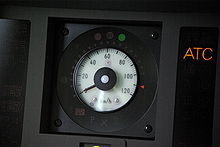
Back Avtomatik qatar idarəsi Azerbaijani Automatic Train Control Danish Automatic Train Control German Control automático del tren Spanish سیستم کنترل خودکار قطار Persian Kulunvalvonta (rautatietekniikka) Finnish ATC (vasúti biztosítóberendezés) Hungarian Automatic Train Control Italian 自動列車制御装置 Japanese 자동 열차 제어 장치 Korean
This article needs additional citations for verification. (May 2009) |

Automatic train control (ATC) is a general class of train protection systems for railways that involves a speed control mechanism in response to external inputs. For example, a system could effect an emergency brake application if the driver does not react to a signal at danger. ATC systems tend to integrate various cab signalling technologies and they use more granular deceleration patterns in lieu of the rigid stops encountered with the older automatic train stop (ATS) technology. ATC can also be used with automatic train operation (ATO) and is usually considered to be the safety-critical part of a railway system.
There have been numerous different safety systems referred to as "automatic train control" over time. The first experimental apparatus was installed on the Henley branch line in January 1906 by the Great Western Railway,[1][2] although it would now be referred to as an automatic warning system (AWS) because the driver retained full command of braking. The term is especially common in Japan, where ATC is used on all Shinkansen (bullet train) lines, and on some conventional rail and subway lines, as a replacement for ATS.
- ^ Hall, Stanley (1987). Danger Signals: An Investigation Into Modern Railway Accidents. London: Ian Allan. pp. 10–11. ISBN 0711017042.
- ^ Calvert, J. B. (2004). "The Great Western Railway Automatic Train Control". University of Denver. Archived from the original on 3 October 2007. Retrieved 14 November 2022.
© MMXXIII Rich X Search. We shall prevail. All rights reserved. Rich X Search